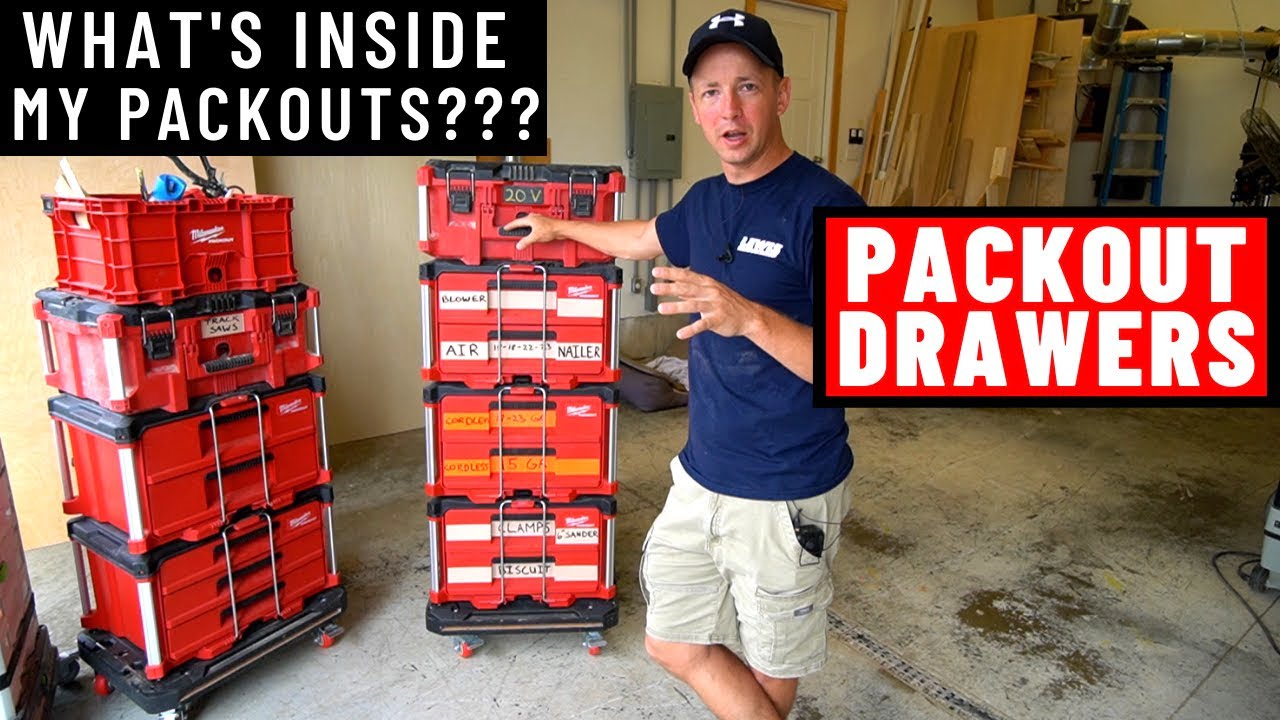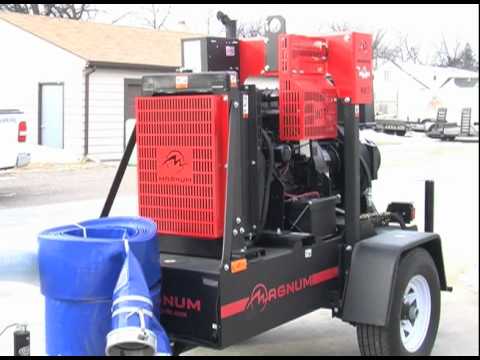
This post may contain affiliate links which means I may receive a commission for purchases made through links. Learn more on my Private Policy page.
– Hey, what's up guys? Welcome back to the channel. We are broadcasting live
from inside my work van. I'm going to show you in this video, we're going to take an inside, look on these Milwaukee Packout
drawers, how I'm using them, how I'm using the Packout accessories to build custom dollies, my power tower, all kinds of good stuff.
We'll go through the
details in this video. You might've seen a recent video where I showed you how I can deploy all the tools in this van
in a matter of minutes. If you haven't seen that
one, check that out. I'll link it in the cards above. But let's dig into this. (whoosh) As you design your Packout system, we have a new ability that
we've never had before. And that is to have drawers go all the way to the bottom of our stack of tools. So we've got a lot of design options in the way we lay out our tool setups. As you can see here, the way I've got these done is, drawers on the lower
portion of the stacks.
And then you've got the option of, you could do drawers the whole way, or you could put an open tote on top, like I've got here and
you can put a box on top, like I've got over here. So I'll show you the way
I've got these stacks set up. On this stack over here. I've got all of my cordless
tools in this large tote on top. The reason I did it this way was because I found I could
not match the efficiency of how many tools I could
get in a tote like this, using the drawers. And for example, like a
circular saw like I have here, that would not fit in
any of these drawers.
So this is basically how
I had this setup done pre-Packout drawer units, and opted just to keep it the same. So whether I'm working on the job site, or coming into the van to grab a tool, I can still access all the tools, because I can open the
lid on the top here. What we don't want to do
is put a unit with a lid on the bottom or middle of the stack, where we have to unstack
stuff to get into this.
So the bad thing with a setup like this, as if I want to access my track saws, which are in this large box, I can do that by taking this
tote off inside the van, and opening the lid here, and I don't have to move
this whole unit in or out. I've got access to my
track saws right here. Or I could leave the tote on, roll it out. And then I would have, I
could lift the whole thing up, you know, part way, even with the tote still
connected to this lid. Inquiring minds may be wondering if you can fit track saws
in a large Milwaukee tote? You can, but it is tricky. So you obviously, you're going to have to detach your bags, and then I've got an HKC over
here, and a TSC 55 right here. The HKC is a little bit smaller, and it's easier to get in the box.
(bell rings) The trick with the TSC is you have to drop your blade down. Okay. That's just annoying. The trick with the TSC 55 is you actually have to
drop your blade down, and use the fast fix lever
here to lock it down. I actually don't have a
blade in this one right now, because it's being sharpened. But that was the only way
that I could figure out, to get this saw to nest into
one of these large boxes. But as you can see here,
it'll close just fine with two track saws like this, Let's just roll through this stack, and I'll show you what I got here.
In this stack, we have a six and a
quarter inch circular saw, oscillating multi-tool, barrel
grip jigsaw with coping foot, and standard jigsaw right there. So pretty good amount of storage in there. And I can also throw
some batteries in there, and plenty of room to spare in that one. Dropping down here, I got a laser Fastool cordless sander, and DeWalt blower. That DeWalt blower just barely fits. It's kind of annoying. But it'll go. In here, this is a really
efficient use of space. I've got four nailers in here, and again, I use a Kaizen inserts, and cut the foam out a little bit, so you can see right where
these units go to get them back. So think that 22 gauge
stapler, 23 gauge pin nailer. We got 15 gauge nailer right here, and 18 gauge nailer right here. You can see that opens and closes easily. That's a really efficient use of space. Moving down here, cordless nailers. I have my 18 gauge
Milwaukee battery adapter with DeWalt battery on it. And under that, the new Milwaukee 23 gauge pin nailer, with an extra battery over here. Again, nice efficient use of space, getting two different
cordless nailers in here.
Down here, not as efficient
DeWalt, 15 gauge nailer. And then I just threw a
couple of hole saws in here, because I needed
somewhere for those to go. Those are the common ones
I use for plumbing vents, and then four inch can lights,
or four inch light box. You know what I mean. When I'm putting wood beams
up, really nice down here, got my ETS 150 sander, sandpaper
stored underneath of it. And then four clam clamps nested in here. The way this works, they
stack on top of each other. So you can see how I cut that
foam out to make that happen. This is really important, because if you don't score
these clam clamps well, they'll bang into each other, and the teeth will get all banged up, and actually go dull, and they won't bite
into the wood very well.
Stair tread gauges over here on the side, and then I've got to block planes right on top of each other, little Lie Nielsen, and
big brother right there. So nice stack there. Down here, Makita biscuit
joiner, battery adapter. Use it with a DeWalt battery, DeWalt cordless router wrench underneath. And with this foam, you
can drill some holes, and store extra drill
bits, extra router bits, that you commonly use
along the outside here, so you've got everything together.
And then this is the jig that I use for pocket door hardware. I'm always using that. So I like to have that close by also. You can see underneath here, this is my custom dolly that I made. I think these are three inch
wheels if I remember right. So on the front, I have locking casters. That way I can just push those down whenever I push these into place, and it's less chance of it moving around.
And obviously I've got the straps on here, holding everything in, which
I covered in the other video. Moving over here, I
already covered this box, got my two, my HKC and
my TSC 55 track saws all is in that box. This isn't as efficient of a
stack as the one on my right. Milwaukee has not yet released bins specifically designed
for these drawer units. But if you have the old style,
Milwaukee Packout boxes, you can take the bins out of those, and they fit pretty good in here. And I have one of the Kaizen
insert cutout foam pieces underneath here, and that puts these boxes
at about the right height. So this is all GRK screws in there. Some more common number 10
biscuits, three inch deck screws, which I use for hanging doors, and then inch and five
eighth drywall screws, which I use for shimming a lot, sandpaper, wood filler, a little bit of a dry lubricant there, just some random stuff in that box.
And down here, I find that these three drawer units are not nearly as efficient for the most part, for a setup like this. I've got my hyper gun,
extra glue, CA glue. That works pretty good, but I don't even have any, actually I do. Okay. I've got caulking under here, but this doesn't seem
really efficient to me. It's just where I've got
some stuff right now. Haven't really found how I
want to use these boxes yet. So anyways, over to the side here, you'll see my latching drawer unit, my self-locking drawer units. I just keep consumables, and hand tools that I don't
use very often, in this area.

And again, I had to come up
with something to do here, because I've got a well
behind there under all that. So you can't roll stuff in to this area, like you can't overhear
where there is no wheel well. I had this spot, which is pretty much the ideal size for a Packout drawer unit. And I haven't really put
anything in this one yet. It's going to be drywall anchors, miscellaneous screws and stuff like that. But I haven't got around
to arranging that yet. Here, I've got this three drawer unit. It just happened that
I had this space open, and it would work pretty
well for a Packout unit.
So that's what I've got here. I don't have anything in it yet. This one will stay on the van, but it'll be used for drywall
anchors, miscellaneous screws, Kreg screws, all kinds of stuff like that, is what I have in mind there. Hopefully Milwaukee comes
out with some screw bins that fit these well. Now coming over here, I have what I'm calling the power tower. And you don't see any Milwaukee
Packout units necessarily. But this is all designed around the Milwaukee Packout system. As you can see, I have the same custom dolly that I made, you can't buy this, I made that, on here as I have on
these units over here. So that'll work with my hand truck. They all roll around really nice. So I made this box for
this air compressor, and this is all modular. So I have the Milwaukee Packout, I don't even know what you call them, but these pieces that you can add so everything clicks together. So I can actually remove
this air compressor unit from this stack, and drop this whole thing down, this microwave unit and charging deal.
It's also fastened to one of
these Milwaukee deals here. So all that can connect and come apart. Last thing I want to show you. I want to give you a closer
look at this dolly that I made, because I think it's pretty awesome. And some of you might
want to make one yourself. There isn't a product on the
market like it as of now. So let's just go ahead and
unstack all this stuff. This is my custom dolly. So the first thing you
have is the Milwaukee, I got to look up what this thing's called. Okay, they call it the base mount. So you're looking for the base mount plate that Milwaukee has. And I believe you can
Mount this on a wall, and you can hang like totes from it, and you can use it at the bottom of a base
like this or whatever. So what I did is I took
one of those plates, I cut out two pieces of
three quarter inch plywood, which one piece is on the top,
one piece is on the bottom.
And then I sandwiched half
inch plywood underneath there. What that does is that
allows your hand truck plate to slide in here. And then I have a half inch
strip going down the center, but your hand truck can slide
in here, or on the other side. So you can get at it from both sides. The other thing nice about it, is since it's a cavity, when you slide your hand truck in there, if your whole stack leans forward, it's not going to completely
fall off the hand truck, because it's locked in there. So did that. Added three inch castors. The wheels on the back are not locking. And then the ones on the front
have the locking mechanisms so that whenever I'm pushing
this into place in the van, I can just click that down and
that wheel's not gonna move. And whenever I want to pull
it out, I can unclick it. Same thing on the job site,
if you're on uneven ground, the dumb things, we'll just
keep rolling around on you.
You just got to click that
down and it won't go anywhere. So I'm pretty thrilled with
myself about this whole design. It's working out really good for me. Took a little bit of time to
make in the shop one night. But I think it's going
to pay dividends for me over the long haul, with the ease of getting
stuff in and out of the van. The other thing with
this dolly that's nice is if you're actually inside your van, and you're trying to just
roll these into place, you can do that.
I have a rubber mat on the base of my van. Sometimes it doesn't
agree with the rubber mat, because the ribs from the van floor kind of telegraph through. If you have plywood on your
floor, it'll work even better. But then of course on the job site, you're wheeling these around, you don't have to have the hand
truck to move stacks around.
They'll just roll around
on your custom dolly. So highly recommend making this
if you've got time to do so. Real quick, over here on this unit that I'm calling my power tower, this was strategically built to have all of my things that
needed plugged in on one unit. So I've got a large air compressor here. I recently switched to
this larger air compressor from a smaller air
compressor plus surge tank. With the smaller air compressor, I had to carry a surge tank. That was kind of annoying, and I wanted to keep everything modular. So I went with a larger air compressor, more air capacity. And I've got that on the bottom here. And then this up here, some of you would remember, I'll link a card here
also, if I remember to, that I built this whole
charging station with microwave, and it was on its own set of wheels that I could move around.
That would have taken
up a space in the van. I opted to take the wheels off of this. I put one of the Milwaukee plates, I think they call it the
custom worktop plate. So this whole thing now
actually is its own unit. And you can take that on or off also. And again, if I didn't want this air
compressor under here, I could remove this whole air compressor, and just drop this whole thing down. I could put a Packout
drawer unit under this. So the idea is, keep it modular, so that you can customize as needed, or as your tools change or needs change. That's kind of the whole
philosophy behind this. Another strategic thing that I did, was I kept this unit
towards the back of the van.
That way, if I'm doing a punchless job or a quick in and out one day, I can run a cord up to
the back of the van, and simply plug this
whole stack into a cord. And I've got power to my air compressor, which I don't hardly use
anymore for work like that, Cause I've got everything cordless now. But air compressor, power to microwave, which is essential for lunch, and power to all of my
battery chargers here, so you can keep things charging. Same thing on the job site, in a situation where I've
got my tools deployed, I can roll this into a
laundry room or bathroom that has an outlet, plug it
in, and everything's just boom, everything's charging.
You can't really see on the inside here, but I've got my headlamps
hooked up to their chargers. I've got a couple of
Fastool chargers in here, micro USB chargers for
my Bluetooth headset, as well as the new Milwaukee headlamp, which I'm trying out right now. So just a lot of versatility there. But again, be strategic
in how you this stuff up, and you'll get a lot more efficiency. To lock this unit in place, I just drilled a couple
holes on my wood partitions, and I'm just using a nice heavy duty bungee
strap across here. That way, if I am leaving
this unit in the van, I can just plug it in and
I can still get access to my microwave. So that's it. I got to get some work done. I hope you guys have
found this video helpful. It's been awesome for me.
I can't say it enough. It's just been an awesome setup. I'm loving using it. So if you've got any questions, let me know in the comments below. If you're new here, don't forget to subscribe
for more content like this. Give the video a thumbs up. And as always, I appreciate
you taking the time to watch and we'll see
you on the next video. (upbeat music).
This post may contain affiliate links which means I may receive a commission for purchases made through links. Learn more on my Private Policy page.






